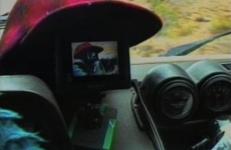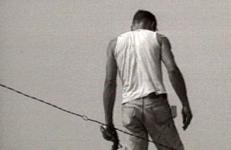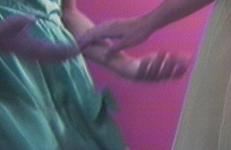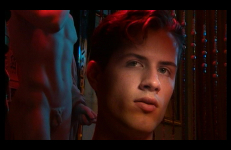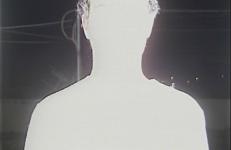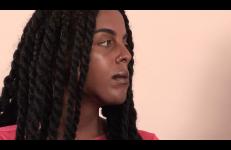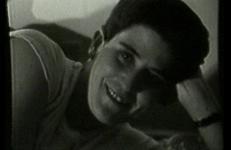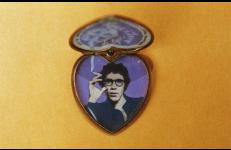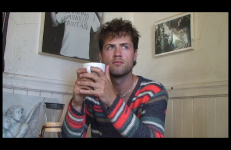Spiro traveled for one year on the backroads of the southern United States gathering footage for this mobile video project. Accompanied by her dog Sam and a video camera, she travels from Virginia to Texas and back. Her van (which breaks down frequently) serves as office, apartment, editing suite, and runabout.
LGBTQ
A Hand in Two Ways (Fisted) is a looping meditation on night as space of mysterious energetic transmissions. Animals, human bodies, children, ritual, and performance are investigated as zones of conflict, desire, and a visceral movement that is more felt than seen.
A Hand in Two Ways (Fisted) is a looping meditation on night as space of mysterious energetic transmissions. Animals, human bodies, children, ritual, and performance are investigated as zones of conflict, desire, and a visceral movement that is more felt than seen.
Handy Man examines the window as a site of voyeurism and surveillance. With his Hi-8 camera, Henricks documents two workers in his interior courtyard. The camerawork has a secretive and furtive feel, treating the male body as an erotic object. This footage forms the basis of a video which attempts to implicate the viewer in processes of exhibitionism and image fetishization. Handy Man is part of a trilogy of works exploring one of the principle metaphors of video: the window.
By using clips of evil queens/witches this video plays off the sadomasochistic lesboerotic subtexts commonly found in children's entertainment. A helpless maiden is tiring of her consensual s/m relationship with her lover, and "evil" queen. She wants to break up. An impassioned monologue in a dungeon with our heroine in wrist cuffs quickly becomes an emotionally messy ending in flames. This video was inspired by the artist's own childhood "kiddie porn", Disney movies which turned her on to no end and kicked off many a prepubescent masturbation session.
Hey Bud revolves around the suicide of Bud Dwyer, a government official who killed himself before a television audience. Zando compares the suicide to a kind of pornographic sex act that plays upon the tension created between exhibitionist and voyeur. It forces viewers to take either an empathetic position vis-a-vis the exhibitionist, or to act as voyeur through release of the repressed desire to see the forbidden face of Death. The piece attempts to understand the power gained through exhibitionism, and how that power is lost through death.
Hokey Sapp Does SPEW features Kate Schechter performing her invented media personality Hokey Sapp interviewing some of the luminaries at SPEW: The Homographic Convergence, a queer zine convention hosted by Randolph Street Gallery in Chicago in May, 1991. SPEW brought together artists, writers, editors of zines, performers, video-makers, activists, and bands from throughout the US and Canada, and marked the explosion of queercore subcultures through unabashed fashion, outrageous politics, humor, and joy.
Klaus Nomi (born Klaus Sperber) was an underground superstar in the East Village arts scene in the 1970s and early 1980s. Known for his dramatic attire and make-up, and his theatrical stage presence, Nomi was a countertenor and could achieve a wide vocal range, allowing him to include operatic embellishments to his musical numbers. He died in 1983 and was one of the earliest artists to die from AIDS.
An allegory recycling images from the past, still relevant to the present moment.
“Horses are lucky, they’re stuck with the war same as us, but nobody expects them to be in favor of it, to pretend to believe in it.”
— Louis-Ferdinand Céline, Journey to the End of the Night, 1932
Land locked souls seek the key to a spiritual doorway that transcends earthly existence.
You, along with them will unlock and enter the "HOUSE OF THE HOLY GHOST", and when inside; be eternally blessed and forever haunted!
How I Love You is an exploration of sexuality among gay men in Lebanon. A couple and three individuals talk about their sex lives, about commitments and failures, about their relationships to their bodies, about their passions and love in a society where homosexuality is still punished by imprisonment. The video uses light to produce a white veil that obstructs seeing, hence rendering character identification almost impossible. Through this obstruction, the video locates itself within a specific social context.
The Hundred Videos is a project undertaken by prolific video artist Steve Reinke, including 100 video works made from 1989-1996. Discussing death, sex, the body, philosophy, and contemporary art, The Hundred Videos defines a unique style of video-essay for the end of the 20th Century.
"Each disquieting image breaks down into a pixel, each pithy phrase into a word, and Reinke's stream of video-thought continues apace. The corpse won't stop talking."
— Jon Davies, Images Festival: Spotlight Essay, April 2018
The Hundred Videos is a project undertaken by prolific video artist Steve Reinke, including 100 video works made from 1989-1996. Discussing death, sex, the body, philosophy, and contemporary art, The Hundred Videos defines a unique style of video-essay for the end of the 20th Century.
"Each disquieting image breaks down into a pixel, each pithy phrase into a word, and Reinke's stream of video-thought continues apace. The corpse won't stop talking."
— Jon Davies, Images Festival: Spotlight Essay, April 2018
The Hundred Videos is a project undertaken by prolific video artist Steve Reinke, including 100 video works made from 1989-1996. Discussing death, sex, the body, philosophy, and contemporary art, The Hundred Videos defines a unique style of video-essay for the end of the 20th Century.
"Each disquieting image breaks down into a pixel, each pithy phrase into a word, and Reinke's stream of video-thought continues apace. The corpse won't stop talking."
— Jon Davies, Images Festival: Spotlight Essay, April 2018
The Hundred Videos is a project undertaken by prolific video artist Steve Reinke, including 100 video works made from 1989-1996. Discussing death, sex, the body, philosophy, and contemporary art, The Hundred Videos defines a unique style of video-essay for the end of the 20th Century.
"Each disquieting image breaks down into a pixel, each pithy phrase into a word, and Reinke's stream of video-thought continues apace. The corpse won't stop talking."
— Jon Davies, Images Festival: Spotlight Essay, April 2018
The Hundred Videos is a project undertaken by prolific video artist Steve Reinke, including 100 video works made from 1989-1996. Discussing death, sex, the body, philosophy, and contemporary art, The Hundred Videos defines a unique style of video-essay for the end of the 20th Century.
"Each disquieting image breaks down into a pixel, each pithy phrase into a word, and Reinke's stream of video-thought continues apace. The corpse won't stop talking."
— Jon Davies, Images Festival: Spotlight Essay, April 2018
This rapid-montage music video for John Sex’s song “Hustle with My Muscle” portrays the singer as a ladies’ man with ample endowment to share. “Can you handle all the man below my belt?” he provocatively asks.
This title is only available on Tom Rubnitz Videoworks: Sexy, Wiggy, Desserty.
Juliana Huxtable was born in Texas and studied at Bard College, NY. An artist working across video, photography, poetry, and music, her practice demands a reexamination of the canon of art history in order to break the cycle of misrepresentation and under-representation in the contemporary art world.
This video is about seduction. The audience is seduced by the female narrator, while at the same time repelled by the seductress' desperate need for love and approval. The title is ironic: although the narrator "likes girls for friends better than boys," the attraction is masochistic and destructive.
Matt Wolf returns to Joe Brainard's iconic poem I Remember (1970) in this videowork. His archival montage combines audio recordings of Brainard reading from the poem, as well as an interview with his lifelong friend and collaborator, the poet Ron Padgett. The result is an inventive biography of Joe Brainard, and an elliptical dialog about friendship, nostalgia, and the strange wonders of memory.
Setting her pixelvision camera on herself and her room, Benning searches for a sense of identity and respect as a woman and a lesbian. Acting alternately as confessor and accuser, the camera captures Benning’s anger and frustration at feeling trapped by social prejudices.
This title is also available on Sadie Benning Videoworks: Volume 1.
Do walls have ‘tales’ to tell? Are ghosts the only ’friend’ one has on sleepless nights when the mind whispers to the soul and a beating heart drums its deeply felt message out into the darkness?
- See what the drum discovers, and you will know why.
In the Queen City is a series of three videos shot in Buffalo, New York that were produced following an invitation from Hallwalls Contemporary Art Center as part of their Ways In Being Gay festival.
An episode of The Brenda and Glennda Show, hosted by Brenda Sexual and Glennda Orgasm. Production Support Provided by Hallwalls Contemporary Art Center.
In the Queen City is a series of three videos shot in Buffalo, New York that were produced following an invitation from Hallwalls Contemporary Art Center as part of their Ways In Being Gay festival.
An episode of The Brenda and Glennda Show, hosted by Brenda Sexual and Glennda Orgasm. Production Support Provided by Hallwalls Contemporary Art Center.
In the Queen City is a series of three videos shot in Buffalo, New York that were produced following an invitation from Hallwalls Contemporary Art Center as part of their Ways In Being Gay festival.
An episode of The Brenda and Glennda Show, hosted by Brenda Sexual and Glennda Orgasm. Production Support Provided by Hallwalls Contemporary Art Center.




